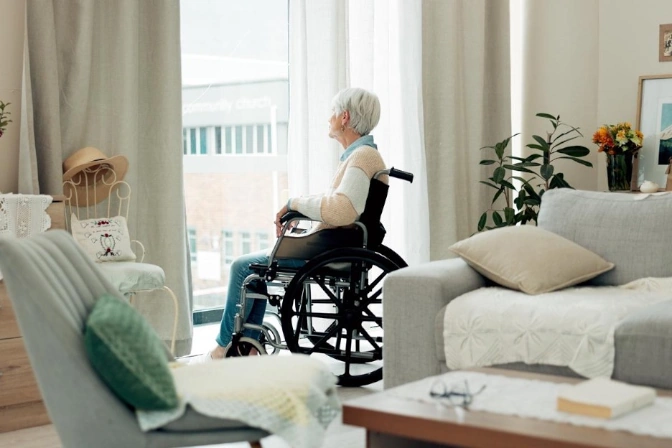Independent Living for Seniors
Independent Living Facilities Guide: How Much It Costs, Who's Eligible, and What Services Are Offered | After55.com

Since senior housing isn’t a one-size-fits-all solution, there are many types to explore. Independent housing is one of those choices, and it can be the perfect pick for certain seniors. Whether you're planning for yourself or a loved one, understanding independent living is the first step toward finding the right senior housing option.
- What is Independent Living?
- Benefits of Independent Living
- Independent Living Services
- Independent Living Costs
- Independent Living Vs. Other Senior Housing
- Your Path to Independent Living Begins on After55.com
- Frequently Asked Questions About Independent Living
What is Independent Living?
Independent living facilities (ILFs) are communities for adults 55 and over, that support independent living and offer benefits to simplify and enhance daily life. This could include meals in a dining area, housekeeping, maintenance, transportation, fitness classes, and social activities. Day-to-day chores are handled so senior residents can enjoy the variety of amenities and perks that come with an ILF.
Who Is Independent Living For?
Independent living communities are ideal for seniors who don’t require daily assistance or medical care and want to maintain their own living space. Seniors often choose ILFs for convenience and services designed with their needs in mind.
ILFs provide this in a variety of ways from a reduction in everyday chores and homeowner responsibilities to social opportunities. By providing these services, ILFs allow residents to focus on enjoying life rather than managing daily chores.
What if you or your loved one needs assistance?
Independent living facilities are ideal for those who don’t need help performing daily living activities because most communities do not offer medical care or nursing staff. However, having the capability to live independently is not a requirement for residency.
If you need assistance and choose to reside in an independent living community, you will have to make your own arrangements. Whether it’s medical support, personal care, or help with daily tasks, you’ll need to arrange and pay for these services.
Some ILFs have a nurse that comes occasionally throughout the week, but most ILFs don’t provide extensive assistance. If you need assistance with bathing, dressing, or mobility, an assisted living community may be a better fit.
Independent Living Accommodations
Independent living facilities typically offer a variety of living spaces, including studio, one-, two-, or three-bedroom apartments. They may also offer cottage-style homes, usually on a single level and often with an attached garage. Townhouses, condos, duplexes, and tiny houses are also becoming popular housing options.
Benefits of Independent Living

Independent living facilities are thoughtfully designed to meet the specific needs of seniors. Explore senior-focused benefits of independent living not typically found in standard housing.
Social, Wellness, and Recreational Opportunities
Living alone can sometimes feel isolating. That’s why companionship with other seniors is an integral part of independent living facilities. Residents in independent living facilities have better opportunities to form meaningful friendships and engage in a variety of activities that appeal to their interests and abilities.
From knitting and yoga to movie nights and game tournaments, every day brings a new chance to bond with others, make joyful memories, and learn new hobbies. Many independent living communities also offer fitness and wellness services to keep the mind and body sharp. To ensure engaging activities, ILFs often hire staff to plan curated events.
Enjoy Exceptional Amenities
To support a fulfilling lifestyle, ILFs offer a wide range of on-site amenities. Because these amenities are on-site, they’re easy for seniors to access. Common amenities in independent living communities include:
- Gym/fitness center
- Pool
- Dining room or multiple dining options
- Community garden
- Walking paths
- Libraries
- Common spaces
- Movie theater
- Event spaces
On-Site Maintenance
Maintenance-free living is one of the greatest benefits ILFs provide. On-site maintenance means residents don’t have to worry about repairs or heavy chores. From housekeeping to lawn mowing to making repairs, the facility staff and their contractors take care of burdensome maintenance responsibilities on behalf of residents.
Dining Services
Preparing healthy meals takes time and effort, and many seniors prefer not to handle it themselves. The good news is most ILFs provide three meals a day, in addition to various snacks and drinks throughout the day (all-inclusive with their monthly rate).
Facilities also arrange tailored food plans for tenants with dietary restrictions, such as food allergies or special diets. For special events or holidays, independent living facilities often provide catering for a festive change of pace.
Safe Living Conditions
Safety is a significant concern for seniors living alone. According to the CDC, there are about three million emergency department visits from seniors due to injuries related to falling. However, modifying a home for safety can be tedious and expensive for seniors and their families.
ILFs are built to accommodate the safety needs of an older population. The facilities are fitted with the infrastructure designed to make daily life easier and safer and allow for easy mobility throughout the community. Residents can also rely on staff and emergency response systems in critical situations.
Pet Friendly
Moving into an independent living facility doesn’t mean you have to say goodbye to your furry friend. Most ILFs are pet-friendly but they often have rules about how many pets you can bring, the type of pets permitted, and size restrictions.
For example, some facilities may only allow cats and dogs, while others may only allow small dogs. Listings provided on After55.com include the community’s pet policy and potential fees.
Rent Is All-Inclusive
Monthly rent payments at ILFs bundle services and amenities into one predictable payment that includes housing, meals, utilities, amenities, etc. Residents don’t have to worry about managing and paying multiple bills, which gives them more freedom to use their time for leisure, recreational activities, and social events.
Since payments are consistent, residents can plan their expenses without unexpected costs. Depending on the community, there may be special fees, like a one-time entrance fee, or services that come at an additional price (often à la carte). All-inclusive rent simplifies payments and supports community-wide amenities.
Independent Living Services

While services may vary across the country, most independent living communities offer the same basic features. If a facility doesn’t provide these services, continue searching After55.com to find a community that better fits your needs.
Usually Covered
- 1-3 meals a day in a community dining environment: When moving to an independent living community, residents can enjoy the comfort of having meals prepared for them. The facility will prepare breakfast, lunch, and dinner. Some even provide catered food for special events, like ice cream socials or pizza parties.
- On-site maintenance: Staff members take care of everything from changing light bulbs to mowing the lawn to mopping floors and even dusting. The convenience of not having to deal with maintenance allows residents to relax and spend their time how they want.
- An emergency call system and safety features: From falls to electrical fires, there’s no way to predict when an emergency might occur. Independent living facilities have safety features built into the infrastructure to curb potential accidents, like grab bars in the shower and handrails along hallways. They also have an internal emergency call system so residents can contact staff when immediate assistance is needed.
- Social, wellness, and recreational activities: At independent living facilities, every day is an opportunity to gain new experiences and explore different activities. Interactive classes, like knitting and painting, are great for keeping the mind sharp and learning a new skill. Social events like game nights or live entertainment provide an outlet for residents to bond with their peers. Fitness classes and facilities help residents keep their bodies and minds strong. Every community is different, so ask which activities they offer to their residents.
Often Offered
- Housekeeping services: Many facilities provide housekeeping services, regularly performing tasks like emptying the trash, sweeping, cleaning the public area bathrooms, and dusting. If there are potential safety hazards (e.g., water spills, a broken smoke alarm, etc.), residents can inform the staff for an immediate response.
- Laundry services and towels and linens: Residents can bring their own linens and towels, but many independent living facilities provide complimentary linens that are washed regularly. They may even offer laundry services, ensuring seniors don’t have to do it themselves. The facility staff might also accommodate your health concerns if you’re sensitive to specific cleaning chemicals.
- Transportation for shopping and community-planned outings: Independent living facilities make life easier for residents, with transportation services being a key component. Most ILFs provide seniors with complimentary transportation for shopping and errands. Some communities offer the option for staff to drive residents in their own vehicles for comfort and convenience.
Not Included
- Concierge services or guest services: Staff who help residents with additional tasks such as coordinating appointments or scheduling transportation are typically offered as optional add-ons.
- Daily assistance, medical care, or nursing care: Most ILSs don’t provide assistance with daily living activities or medical care. Home services can be arranged by residents who pay their provider directly.
Independent Living Costs
According to U.S. News, the average cost of independent living ranges from $3,000 to $4,000 per month, but this can vary by city and state. The cost also depends on the size of the apartment or cottage and the amenities offered by the community.
Pricing can also be impacted by additional fees, such as a second-person fee, entrance fee, or community fee. These fees are common because they help cover the cost of added services provided by the community. Depending on the community, the fees may or may not be refundable.
Payment methods for independent living
Because there is little need for daily task support or medical assistance, independent living is one of the most affordable senior living options available. But choosing the ILF that’s right for you or your senior loved one means finding a community that fits within your long-term budget. Even though independent living facilities only accept private pay, there are several payment options, including:
- Personal funding: Most residents cover their independent living costs with personal funds, like retirement income, savings, or investment gains.
- Long-term care insurance: This type of insurance may pay for expenses like meals, transportation, and housekeeping. However, long-term care insurance usually won’t cover all your independent living costs.
- Life insurance: If you sell your life insurance policy for a profit, you may be able to use the money to help fund some of your independent living costs.
- Home or property equity: Some residents own a home or property before deciding to move into an independent living facility. Whether you sell or rent the property, you can use the income to fund your independent living care. You can even convert the equity of a reverse mortgage into funding to cover the ILF costs.
- Bridge loan: A bridge loan is a short-term loan you can use to help pay for independent living while you sell your home, property, or other assets to cover the expense.
Independent Living Vs. Other Senior Housing

Sometimes independent living communities stand alone, while others are part of larger campuses that include several types of senior housing. To better understand independent living, it helps to see how it compares to other types of senior housing:
Independent Living vs. Assisted Living
Independent living facilities are primarily for seniors who can take care of themselves with minimal assistance, while residents in assisted living facilities (ALFs) need help with their daily activities. ILF residents don’t want to deal with the upkeep and responsibilities of homeownership; or they may want to find companionship with other retirees.
Assisted living helps residents complete basic tasks like running errands, tracking medications, and grooming. ALFs are costlier because they require more staff and personalized care for the residents.
Independent Living vs. Home Care
While seniors who opt for independent living move into a shared community, seniors who utilize in-home care receive personalized care from the comfort of their own residence. You could hire a personal caregiver to help cook dinner, clean the house, and shop for groceries. Long-term home care is usually more expensive because it requires more specialized care for the client.
ILFs provide 24/7 access to on-site staff members, but home care is typically an additional service or one you arrange yourself. The availability of home care services can vary widely based on the resident’s specific requirements. For example, you could hire a live-in caregiver or one who only comes three times a week.
Independent Living vs. Senior Apartments
Like ILFs, senior apartments are built for an older population, with features like bathroom handrails, wider doorways, and elevators. Many communities offer a select number of senior apartments in addition to regular apartments. Or it could be a specific community of only senior apartments. But unlike ILFs, senior apartments lack senior-focused amenities, and rent payments are not all-inclusive.
Rent usually covers security, utilities, and maintenance, but residents are still responsible for housekeeping, meals, transportation, and laundry. Because senior apartments only provide the essentials, it is a much more cost-effective option than independent living facilities.
Independent Living vs. Active Adult Communities
Active adult communities are senior-focused neighborhoods (usually with a minimum age requirement) that put residents right into the action. They are often built in central locations where seniors can walk to shops, eateries, entertainment, and other convenient destinations.
Active adult communities don’t offer services like meals, housekeeping, transportation, laundry, and 24/7 emergency assistance. However, they may provide on-site amenities, like a golf course, pool, tennis court, fitness center, and clubhouse.
Independent Living vs. Nursing Homes
Nursing homes provide medical care to seniors with serious health issues or disabilities around the clock. These facilities are usually fully equipped and staffed with healthcare professionals to manage everything from medication management to physical therapy.
Independent living has much more of an autonomous focus where older adults can be active and live without assistance. They are less structured and don’t offer the intense medical care that a nursing home does.
Independent Living vs. Memory Care
Memory care facilities create a secure and supportive environment for those with Alzheimer's or related dementias. They provide specialized care from trained nurses and staff, along with safety-focused layouts tailored to residents with memory issues. Independent senior living has none of these specialized features.
Your Path to Independent Living Begins on After55.com
After55.com makes it easy to find an independent living facility using the living type filter. Simply enter your city and select “Independent Living” on the dropdown menu under “Living Type.” Your search now only includes independent living communities so you can skip the hassle of sorting through pages of listings. Search smarter on After55.com and spend more time doing what you love.
Frequently Asked Questions About Independent Living
What factors affect the cost of independent living?
Location, type of community, services, and package structure affect the cost of independent living facilities:
- Location: Where the independent living community is located plays a significant factor in the costs. A facility in a large city usually costs more than one in a rural area.
- Community type: Luxury communities are more expensive because they offer extra amenities. Check if a community offers studios, one-bedroom, or two-bedroom apartments, as these come with different price tags.
- Provided services: The more services a community offers, the greater chance it comes at a higher cost. For example, an ILF with a pool, golf course, health center, and theater will likely cost more than a community that only provides the basics.
- Package structure: ILFs adopt different pricing structures depending on their service package. Some may function as an all-inclusive senior housing option where the monthly rent payment covers everything. Other facilities take an “a la carte” approach so residents can individually select the services they want to pay for.
- Extra fees: Some facilities charge extra for things like maintenance or pets. Make sure you ask about these costs to ensure you can fit them within your budget.
What is the average cost of living in an independent living facility?
U.S. News says the average cost of an independent living facility is $3,000 to $4,000 a month. The cost of ILFs range between $1,400 to $6,600 a month based on location, amenities, and services.
How do you know if independent living is right for you?
Independent living may be right for you if you’d prefer to avoid the responsibilities of homeownership and enjoy being part of a senior community. It’s ideal for those who don’t need help with daily tasks.
Can you pay for independent living with Medicaid or Medicare?
No, Medicaid and Medicare don’t cover independent living costs because these communities don’t offer medical care or assistance with daily activities.